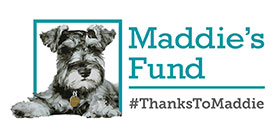Separation anxiety ranges from mild to severe, and is triggered by a dog’s separation from their guardians. Some dogs experiencing separation anxiety will become agitated when their guardians prepare to leave. Others become depressed prior to their guardians’ departure while others try to prevent their guardians from leaving. Most dogs with separation anxiety will display some of the symptoms listed below within minutes of being left alone. The first step to finding a solution is to determine whether your dog has true separation anxiety or is simply lacking polite house manners or suffering from isolation stress.
Possible symptoms of separation anxiety
- Destructive behavior – Destructive behavior may be related to separation anxiety if it occurs near doors or windows, if it only occurs when your dog is alone, and/or it occurs with such intensity that your dog may cause harm to herself.
- Inappropriate elimination or marking – A puppy or unneutered adult dog urinating on the rug is not a sign of separation anxiety. An adult dog who has been housetrained and is now eliminating indoors may be experiencing separation anxiety but it is necessary that your dog has a veterinary exam to rule out medical conditions that may account for the inappropriate elimination.
- Vocalization– Excessive, repetitive barking (without the presence of stimuli like the mailman or a dog walking by) may indicate separation anxiety.
- Salivation and lack of appetite – Some easily overlooked signs that your dog is suffering from separation anxiety are excessive salivation and loss of appetite before and during your absence.
- Pacing – Signs of an anxious dog include pacing, yawning, lip licking, drooling and stretching. Pacing and salivating often begin as you prepare to leave because your pre-departure cues (picking up keys or putting on work shoes) have become the triggers of your departure.
What to do if you suspect separation anxiety
It is a normal biological response for a puppy to be anxious when left alone so the diagnosis of separation anxiety does not apply to puppies and most adolescent dogs.
First, rule out common behavior problems like housetraining, lack of exercise, adolescent chewing, barking due to stimuli, etc. Ask yourself, is my dog getting enough exercise? Does my dog have too much freedom in the house? Does my dog have appropriate play things and interactive toys? Does my dog have housetraining accidents at times other than when she is alone? Does my dog’s barking correspond to the neighbors walking by the front window or the mailman?
Set up a video recorder to tape your dog’s behavior while you are gone.
Keep a detailed daily journal of your dog’s behavior. How much time does she spend alone vs. at your side? Does she eat, play or seek attention? Is she demanding (barking, nudging, jumping up) or does she appear depressed? Pay special attention to her behaviors in response to your daily actions (making dinner, going out the door, putting on your coat, sitting on the couch). The more information you can provide about your dog’s behavior, the faster you and a professional trainer will be able to develop a specific behavior modification plan.
If your dog is exhibiting symptoms of separation anxiety, or any of the other common behavior issues listed above, contact a CPDT (Certified Professional Dog Trainer) to develop an individualized plan for your dog. Your veterinarian may also be able to help with medications that combined with behavior modification, may decrease your dog’s anxiety level and make treatment progress more quickly.
What not to do
- Punishment – Anxious behaviors are not the result of disobedience or spite, but rather distress responses. Punishment will only increase your dog’s anxiety and damage your relationship with your dog.
The basics of treatment
- Prevent exposure –When treating separation anxiety, it is crucial that your dog not be left alone except during desensitization sessions. Consider bringing your dog to work, dog daycare, hiring a pet sitter, or having her stay with a friend when you must be away from home. The more she is exposed to the trigger that causes her anxiety the harder it will be to desensitize her to it.
- Practice leadership – Practice ‘Say Please’ training techniques to strengthen your relationship and build your dog’s confidence. Your dog needs guidance, stability, and leadership and this should come from you.
- Desensitization/counterconditioning – Depending on the duration and severity of your dog’s anxiety, treatment may involve a simple counterconditioning treatment (teaching your dog that what she fears predicts something that she loves) to a more complex plan including a combination of training techniques, medication and management. For mild cases, a treatment plan may involve basic manners training and giving your dog a stuffed Kong when you leave. For severe cases, a treatment plan may involve medication from your veterinarian and working with your dog on very short separations that never produce anxiety. Desensitization and counterconditioning are complex and tricky to implement and are typically only implemented with the help of a certified trainer or behaviorist.
- Management – Medications, anxiety wraps, scent therapy, DAP (dog appeasing pheromone) products, and other tools can be helpful for reducing your dog’s anxiety. Always consult with your veterinarian before giving your dog any type of medication for a behavior problem
Not all dog trainers or behaviorists are able to work with separation anxiety; Josh Boutelle of City Pups SF is a local Certified Separation Anxiety Trainer.
Mission Possible is a wonderful online course designed as a do-it-yourself protocol for overcoming your dog’s separation anxiety that was created by separation anxiety expert Malena DeMartini. You may also want to check out the treating separation anxiety Facebook page.
Download the Separation Anxiety training handout here.
